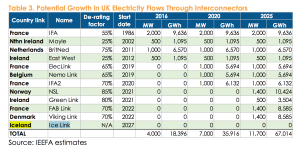IEEFA presents IceLink to be operational in 2027
In a new report, the Institute for Energy Economics and Financial Analysis (IEEFA) introduces IceLink HVDC electric cable between Iceland and Britain as becoming operational as soon as 2027. The IEEFA conducts research and analyses on financial and economic issues related to energy and the environment. The Institute’s mission is to accelerate the transition to a diverse, sustainable and profitable energy economy and to reduce dependence on coal and other non-renewable energy resources.
 One of the core findings in this new report, titled Electricity-Grid Transition in the UK: As Coal-Fired Generation Recedes, Renewables and Reliable Generation Can Fill the Gap, is that the UK grid is coping well with a coal phase-out, but requires greater investment in reliable generation to back up renewable power than the country is currently making. The report also explains how the UK is currently encouraging new investment in interconnectors; subsea cables linking its grid to neighbouring countries. The authors of the report claim such investment to be overdue, given present interconnection stands at 4GW, or 5% of existing generating capacity; just half the 10% benchmark proposed by the European Commission.
One of the core findings in this new report, titled Electricity-Grid Transition in the UK: As Coal-Fired Generation Recedes, Renewables and Reliable Generation Can Fill the Gap, is that the UK grid is coping well with a coal phase-out, but requires greater investment in reliable generation to back up renewable power than the country is currently making. The report also explains how the UK is currently encouraging new investment in interconnectors; subsea cables linking its grid to neighbouring countries. The authors of the report claim such investment to be overdue, given present interconnection stands at 4GW, or 5% of existing generating capacity; just half the 10% benchmark proposed by the European Commission.
According to the report, interconnection can smooth variability in UK wind power by reaching into wider weather systems, and it can diversify generation. For example, the UK can receive electricity from hydropower stations in Norway and Iceland, where peak supply matches UK’s peak demand in winter. Also, inetrconnectors open access to various generation technologies elsewhere in continental Western Europe and to wind power in Ireland. In the UK, interconnection can lead to consumer savings of GBP 1 billion annually as a result of cheaper electricity imports, rather than having to build up all the necessary capacity within the UK.
 The table at left is from the said report by IEEFA, explaining how potential electricity imports through interconnectors may offer UK an additional annual supply of 49 TWh by 2025 (if all projects proceed). This would be equivalent to more than a third of UK gas generation in 2016. One of the listed interconnector-projects is the IceLink cable, which would add close to 5 TWh. According to Natinal Grid, the IceLink is planned to be a 1,000 km long subsea cable with a capacity of 1,000 MM.
The table at left is from the said report by IEEFA, explaining how potential electricity imports through interconnectors may offer UK an additional annual supply of 49 TWh by 2025 (if all projects proceed). This would be equivalent to more than a third of UK gas generation in 2016. One of the listed interconnector-projects is the IceLink cable, which would add close to 5 TWh. According to Natinal Grid, the IceLink is planned to be a 1,000 km long subsea cable with a capacity of 1,000 MM.
National Grid expects that the landing points for the cable will be in Northern Scotland and Southeastern Iceland. It will connect the electricity networks of Iceland and Great Britain, enabling electricity to flow in both directions and allowing electricity to be traded between the two countries.
As mentioned earlier, the IceLink-project is currently projected to be finished in 2027. According to National Grid it will make a positive contribution to European energy-policy objectives, helping Great Britain towards a minimum 10% interconnection target, facilitating renewables integration, reducing reliance on fossil fuels, and resulting in socio-economic welfare benefits. More information about IceLink can be seen on the website of Icelandic national power company Landsvirkjun.




